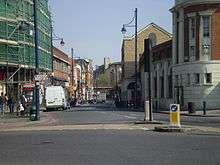Coldharbour Lane

Coldharbour Lane is a road in South London that leads south-westwards from Camberwell to Brixton. In total the road is over 1 mile long with a mixture of residential, business and retail buildings - the stretch of Coldharbour Lane near Brixton Market contains shops, bars and restaurants. The junction of Coldharbour Lane and Denmark Hill in Camberwell SE5 marks part of the boundary between Lambeth and Southwark boroughs. The other end of Coldharbour Lane meets Acre Lane in central Brixton to form the A2217.
The Loughborough Junction area, surrounding the railway station, marks the approximate centre point of Coldharbour Lane and the change in postcode from SE5 to SW9.
History
Coldharbour Lane was formerly known as Camberwell Lane.
Former British Prime Minister John Major lived in a flat in Coldharbour Lane when a child in the mid-1950s.[1]
The lane close by Brixton Market became very derelict by the mid 60's, when many drug houses flourished dealing mainly in cannabis.
In 1981 the Brixton riots occurred in roads near Coldharbour Lane and some windows were broken on the street itself.[2] With the support of community leaders and shop owners, there are plans to set up a mini-police station on Coldharbour Lane in the former premises of a drug dealer.[3]
Origins of the name
A possible derivation of the name is Cool Arbour Lane, dating from the time Camberwell was in the country. This is cited in 'The Streets' by Anthony Quinn (2012) as the place the Camberwell Beauty was first sighted.
A "cold harbour" was an uninhabited shelter for travellers, often along a well-known route, somewhat similar to a modern bothy. Unlike an inn, there were no staff, food or drink to be had. There would be a roof, door and possibly a simple hearth, although it was the traveller's responsibility to gather fuel. They were generally little more than open-faced barns or animal shelters.[4]
J. C. Hahn, in Notes and Queries Series 3, 7, 253–254 (1 April 1865) and later in Series 3, 8, 71–72 (22 July 1865) wrote an article entitled "Remarks on the Origin of 'Cold Harbour'".[5]
In this, the author remarks upon relatively early equivalent place names in Germany and traces back the origins of Coldharbour/Cold Harbour to the Old High German Kalte Herberge. There is a village in Germany and another in Austria called Kaltherberg. This etymology was accepted by the authors of the dictionary Merriam-Webster. Our author concludes that "our Cold Harbour was a name given to any cold abode, cold retreat, brought over to England by our Saxon ancestors—Cold Harbour = Cold Station, Cold House, Cold Lodge." And thus has a wider meaning than that attributed by the supporters of a basic type of lodgings.
"Coldharbour" also survives as the name of a village in Surrey, and Bristol has both a "Coldharbour Road" and a "Cold Harbour Lane".
Coldharbour Lane also gives its name to Coldharbour ward in Brixton although approximately one third of Coldharbour Lane is located in Herne Hill ward.
Pubs and bars
There are several pubs and bars on Coldharbour Lane: the Prince of Wales in Brixton [6] which has been on the same site since 1800;[7] the Prince Albert[8] which has occasional live music and quiz nights;[9] the Dogstar,[10] a "three-floor DJ bar";[11] Living;[12] Club 414[13]and the Plough. The Green Man,[14] the Angel,[15] the Enterprise and the Hero (latterly the Junction) all ceased trading between 2000 and 2007 .
Mentions in culture
With a nod to The Rolling Stones' Exile on Main St., Brixton-based band Alabama 3 named their debut album Exile on Coldharbour Lane after the road. Although Woke Up This Morning on this album mentions Coldharbour Lane, the mention is omitted from the "Chosen One Mix", used as the theme song for The Sopranos.
"Coldharbour Lane" — with the hook "So long / I've done my time / Coldharbour Lane / Goodbye" — is a single from The Quireboys's 2001 This Is Rock'n'Roll release.
Markus Schulz named his own recording label "Coldharbour Recordings" in honour of the time when he lived in a flat in Coldharbour Lane.
The Camberwell Beauty
The rare migrant butterfly, the Camberwell Beauty Nymphalis antiopa, was so named after the discovery of two specimens in Coldharbour Lane in 1748.[16][17] The butterflies had probably arrived as stowaways on ships delivering timber from Scandinavia to the Surrey Docks two miles to the north [18]
References
- ↑ John Major - Biography
- ↑ "Brixton Riots, 10-12th April 1981", an eye-witness accounts of the Brixton disorders in and around the Frontline, Atlantic Road, Railton Road, Coldharbour Lane and Brixton Road, Brixton, Lambeth, London.
- ↑ "Ghetto fabulous". The Guardian. London. 2005-04-24. Retrieved 2010-04-30.
- ↑ "Coldharbour". The Phrase Finder.
- ↑ J. C. Hahn, Two articles on the origin of the name Coldharbour.
- ↑ Prince of Wales, Brixton, London, SW9 8HH - pub details # beerintheevening.com
- ↑ Prince of Wales hotel, Coldharbour Lane, Brixton. Historical Brixton - old and new photos of Brixton, Lambeth, London, SW9 and SW2
- ↑ The Prince Albert, 418 Coldharbour Lane, Brixton SW9 8LF
- ↑ Prince Albert, 418 Coldharbour Lane, London - London Public Houses & Inns - All in London
- ↑ Dogstar, Brixton, London, SW9 8LQ - pub details # beerintheevening.com
- ↑ Dogstar, 389 Coldharbour Lane, Brixton SW9 8LQ
- ↑ Living | 443 Coldharbour Lane | London | SW9 8LNdead link]
- ↑ Club 414 | 414 Coldharbour Lane | London | SW9 8LFdead link]
- ↑ The Green Man | 225 Coldharbour Lane | London | SW9 8RR
- ↑ The Angel | 354 Coldharbour Lane | London | SW9 8QH
- ↑ Asher, Jim. The Atlas of Butterflies of Britain and Ireland, Oxford University Press.
- ↑ Thomas, Jeremy, and Richard Lewington. The Butterflies of Britain and Ireland, Dorling Kindersley.
- ↑ Emmet, A. M. and Heath, J. (1989). The moths and butterflies of Great Britain and Ireland. Harley Books, Colchester.
Coordinates: 51°27′57″N 0°06′09″W / 51.4659°N 0.1024°W